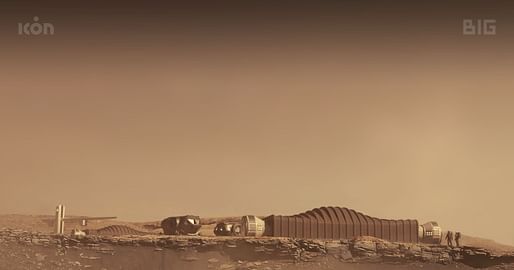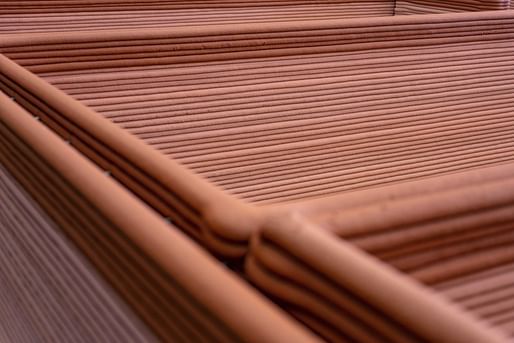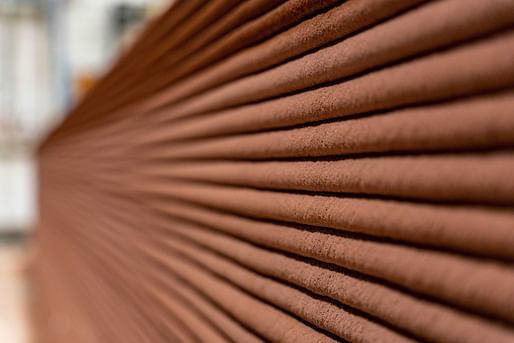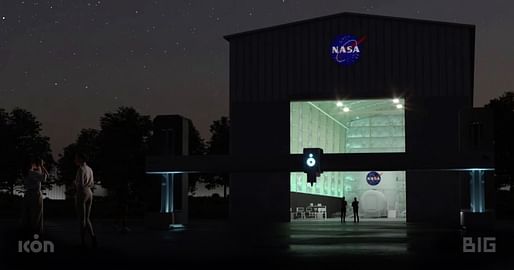
Images have been revealed of a 3D-printed structure being built to help simulate life on Mars. Named Mars Dune Alpha, the habitat was designed by BIG-Bjarke Ingels Group for NASA and advanced construction developer ICON, intended to form part of future long-duration, explorative science missions. The 1,700 square-foot structure is currently being built at Johnson Space Center in Houston, Texas, where it will host a simulation environment for future space explorers.

The habitat has been designed along varying levels of privacy. Four private crew quarters are located on one end of the habitat, while dedicated work stations, medical stations, and food-growing stations are located at the opposite end. Shared living spaces will connect the two zones in the middle. Varying ceiling heights, responding to an arching shell structure, accentuate the unique experiences and uses of each area to avoid a sense of monotony or user fatigue. Meanwhile, a mix of fixed and movable furniture will allow crewmembers to reorganize the habitat according to their daily needs, as will the customizable lighting, temperature, and sound control, helping regulate the daily routine, circadian rhythm, and overall wellbeing of the crew.

The habitat is currently being 3D-printed within an indoor environment at the Johnson Space Center using ICON’s next-gen Vulcan construction system. In Fall 2022, a crew of potential future astronauts will take up residency within the structure as part of NASA’s Crew Health and Performance Exploration Analog (CHAPEA) program. The CHAPEA program seeks to provide valuable insights for NASA’s space food system as well as physical and behavioral health and performance outcomes for future space missions.

Throughout CHAPEA’s three one-year Mars surface simulation missions, data will be gathered and used by NASA to inform risks and resource needs that will support crew health and performance while living on Mars during an extended mission. Part of Mars Dune Alpha’s research is also to determine the future potential of 3D-printed space exploration habitats which, when combined with additive construction technology, can eliminate the need to launch large quantities of building materials on multiple flights.

“Together with NASA and ICON, we are investigating what humanity’s home on another planet will entail from the human experience,” says Bjarke Ingels. “The data gained from this habitat research will directly inform NASA’s standards for long-duration exploration missions, and as such, will potentially lay the foundation for a new Martian vernacular. Mars Dune Alpha will take us one step closer to becoming a multiplanetary species.”

The habitat is the latest innovation from ICON in 3D-printed space. In recent years, the Austin-based company has completed two dozen 3D-printed structures across central Texas, printed a small community for impoverished residents in Mexico, and recently announced it was entering the 3D-printed multi-home housing market in Texas with a set of four buildings in East Austin. The company has also teamed up with BIG and SEArch+ to create an off-world building system for the Moon.

Back on Earth, meanwhile, a series of 3D-printed breakthroughs has emerged within architecture and construction. Last month, the world’s first 3D-printed concrete footbridge and 3D-printed steel footbridge were both unveiled, while the Fibonacci House became the world’s first Airbnb listing to be comprised predominantly of 3D-printed parts. Denizen has recently unveiled a 3D-printed office pod for the future of remote working, while Habitat for Humanity has announced it is building its first 3D-printed house in the United States, seen as an important step in the organization’s mission to offer affordable housing across the country.
No Comments
Block this user
Are you sure you want to block this user and hide all related comments throughout the site?
Archinect
This is your first comment on Archinect. Your comment will be visible once approved.